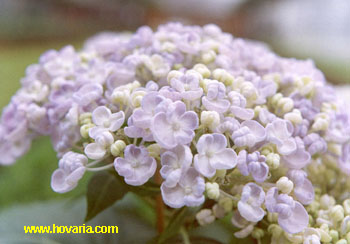This group of hydrangeas is well known. They are often offered as an indoor plant that can be planted in the garden during or after flowering. It is the most colourful group of the hydrangea family. Height up to 1-1½ metres.
Spherical shape: globose flowerhead (mophead)
The Hydrangea macrophylla with a flower head of a spherical shape is the most common
hydrangea and is best known. The flower colour can be red, pink, white and blue. It
must be mentioned, however, that all blue hydrangeas naturally are pink
(See ‘Colouring blue’ in
the care assignments). Some good varieties of mopheads are Hovaria® ’Homigo’ (blue or pink), Hovaria® ’Hobergine’ (purple or red), Hovaria® ’Hopaline’ (very soft pink or opal blue) and
Hovaria® ’Holibel’ (white).
Lacecap/Teller

The Teller hydrangeas, also called lacecaps, are characterized by their rather flat and nearly disk-shaped inflorescences. The center of little fertile flowers is surrounded by a circle of large sterile flowers. The lacecaps are available in the colours of red, pink, blue and white. A very special lacecap is the ’Fireworks’ Hydrangea whose sterile flowers are double flowering and look like little stars.
Lilac flowering hydrangea

In 1992 this hydrangea was introduced in Europe by Koos and Wilko Hofstede as an
indoor plant. During that year and the years after, many of these hydrangeas have
also found a place in the garden, where they can flower beautifully. However, they
are less hardy than the average Hydrangea macrophylla and after a severe winter no
flowers or few flowers are produced. In acid soil blooms will acquire all sorts of
tints from violet to blue and, in calcifereous soil, a pink colour.
The ‘Lilac Hydrangea’ owes its name to the fact that the florets look like those of a
lilac tree. Although sometimes wrongly called ’Ayesha’, the true botanical name is
Hydrangea macrophylla ’Uzu’.
If you don't see an index on this page, please click here
![]()
Created by Koos and Wilko Hofstede Copyright © 2000-2007. All rights reserved.
Last modified: 11 November 2002